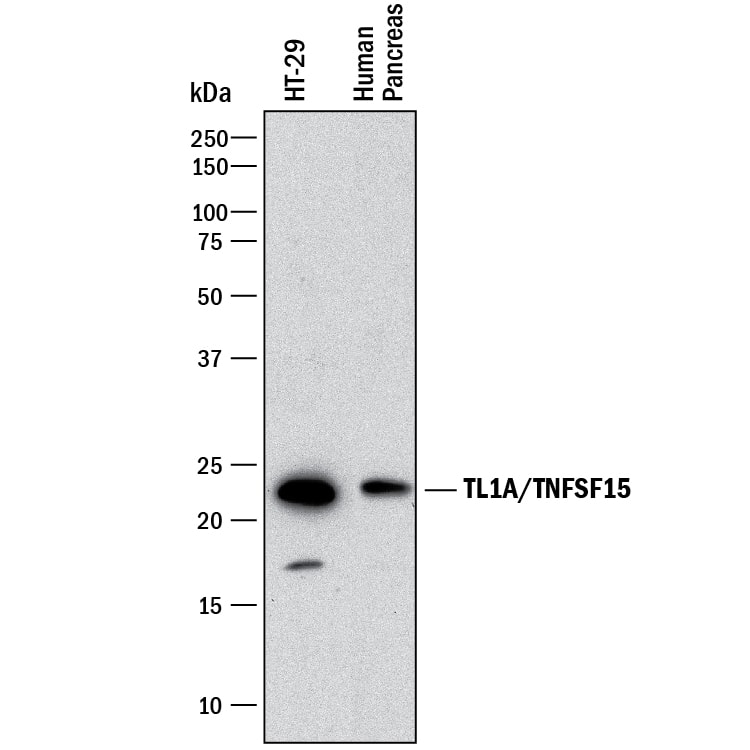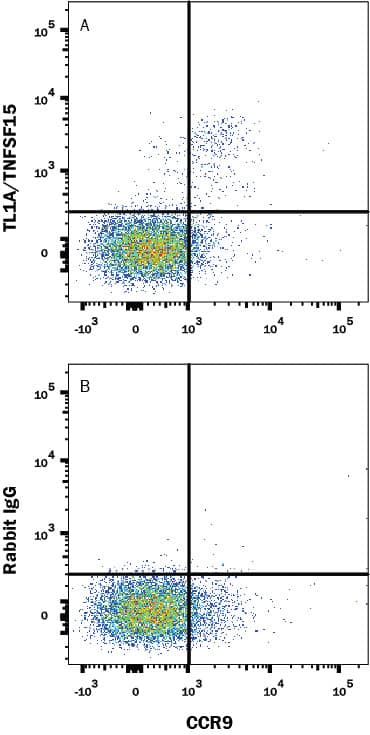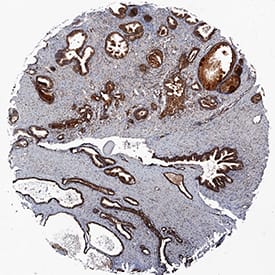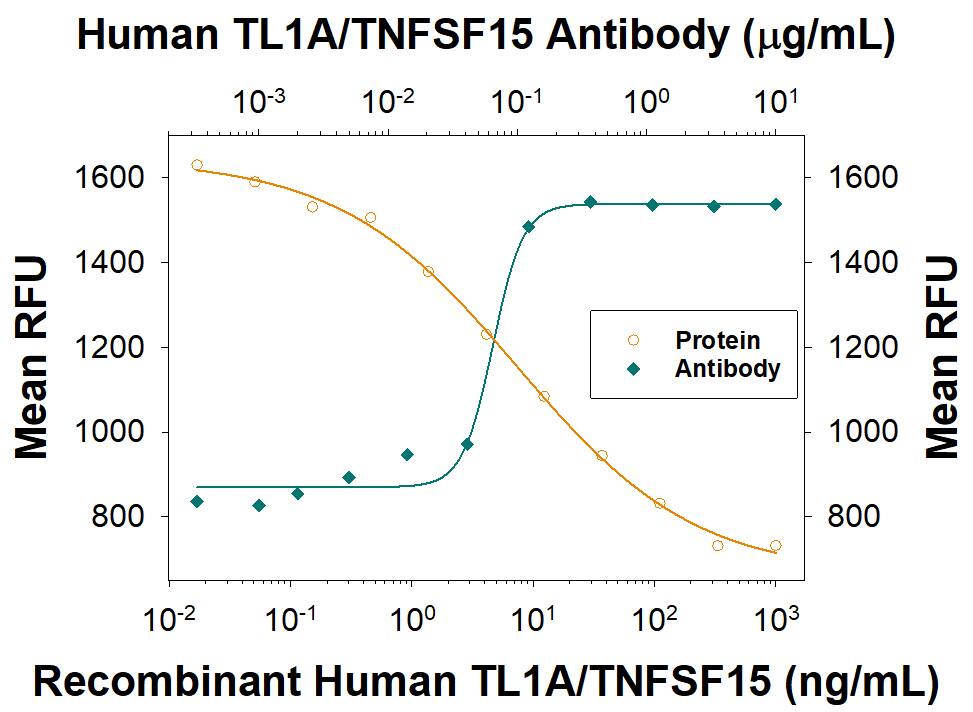Human TL1A/TNFSF15 Antibody
R&D Systems, part of Bio-Techne | Catalog # MAB74422


Key Product Details
Species Reactivity
Applications
Label
Antibody Source
Product Specifications
Immunogen
Leu72-Leu251
Accession # O95150
Specificity
Clonality
Host
Isotype
Endotoxin Level
Scientific Data Images for Human TL1A/TNFSF15 Antibody
Detection of Human TL1A/TNFSF15 by Western Blot.
Western blot shows lysates of HT-29 human colon adenocarcinoma cell line and human pancreas tissue. PVDF membrane was probed with 1 µg/mL of Rabbit Anti-Human TL1A/TNFSF15 Monoclonal Antibody (Catalog # MAB74422) followed by HRP-conjugated Anti-Rabbit IgG Secondary Antibody (HAF008). A specific band was detected for TL1A/TNFSF15 at approximately 22 kDa (as indicated). This experiment was conducted under reducing conditions and using Immunoblot Buffer Group 1.Detection of TL1A/TNFSF15 in Human PBMCs by Flow Cytometry.
Human peripheral blood mononuclear cells (PBMCs) were stained with (A) Rabbit Anti-Human TL1A/TNFSF15 Monoclonal Antibody (Catalog # MAB74422) or (B) Rabbit IgG control antibody (MAB1050) followed by Goat anti-Rabbit IgG PE-conjugated Secondary Antibody (F0110) and Mouse anti-Human CCR9 APC-conjugated Monoclonal Antibody (FAB1791A). Cells were gated on CD4+ lymphocytes using Mouse anti-Human CD4 FITC-conjugated Monoclonal Antibody (FAB3791F). View our protocol for Staining Membrane-associated Proteins.TL1A/TNFSF15 in Human Prostate Cancer Tissue.
TL1A/TNFSF15 was detected in immersion fixed paraffin-embedded sections of human prostate cancer tissue using Rabbit Anti-Human TL1A/TNFSF15 Monoclonal Antibody (Catalog # MAB74422) at 0.3 µg/mL for 1 hour at room temperature followed by incubation with the Anti-Rabbit IgG VisUCyte™ HRP Polymer Antibody (VC003). Before incubation with the primary antibody, tissue was subjected to heat-induced epitope retrieval using Antigen Retrieval Reagent-Basic (CTS013). Tissue was stained using DAB (brown) and counterstained with hematoxylin (blue). Specific staining was localized to cytoplasm in epithelial cells. View our protocol for IHC Staining with VisUCyte HRP Polymer Detection Reagents.Applications for Human TL1A/TNFSF15 Antibody
CyTOF-ready
Flow Cytometry
Sample: Human PBMC lymphocytes and HT-29 human colon adenocarcinoma cell line
Immunohistochemistry
Sample: Immersion fixed paraffin-embedded sections of human prostate cancer tissue
Western Blot
Sample: HT‑29 human colon adenocarcinoma cell line and Human pancreas tissue
Neutralization
Formulation, Preparation, and Storage
Purification
Reconstitution
Formulation
Shipping
Stability & Storage
- 12 months from date of receipt, -20 to -70 °C as supplied.
- 1 month, 2 to 8 °C under sterile conditions after reconstitution.
- 6 months, -20 to -70 °C under sterile conditions after reconstitution.
Background: TL1A/TNFSF15
TL1A is a type II transmembrane protein belonging to the TNF superfamily and has been designated TNF superfamily member 15 (TNFSF15). Human TL1A is a 251 aa protein consisting of a 35 aa cytoplasmic domain, a 24 aa transmembrane region and a 192 aa C-terminal extracellular domain. It is a longer variant of the previously cloned TL1 (also known as VEGI) that is possibly a cloning artifact. TL1A is predominantly expressed in endothelial cells and its expression is inducible by TNF-alpha and IL-1 alpha. TL1A binds with high affinity to death receptor 3 (DR3), which is now designated TNF receptor superfamily member 25 (TNFRSF25). DR3 was formerly designated TNFRSF12 when it was thought to be the receptor for TWEAK/TNFSF12. DR3 is expressed primarily on activated T cells. Depending on the cell context, ligation of DR3 by TL1A can trigger one of two signaling pathways, activation of the transcription factor NF-kappa-B or activation of caspases and apoptosis. On primary T cells, TL1A induces NF-kappa-B activation and a costimulatory signal to increase IL-2 responsiveness and the secretion of proinflammatory cytokines. However, in a tumor cell line, TF-1, TL1A has been shown to induce caspase activity and apoptosis. These effects of TL1A are blocked by the secreted, soluble decoy receptor 3 (DcR3), also known as TR6 and TNFRSF6B, which compete with DR3 for binding to TL1A. Consistent with the observed in vitro activities, TL1A promotes ex vivo splenocyte expansion and enhances in vivo graft-versus-host-response.
References
- Migone, T.S. et al. (2002) Immunity 16:479.
Long Name
Alternate Names
Gene Symbol
UniProt
Additional TL1A/TNFSF15 Products
Product Documents for Human TL1A/TNFSF15 Antibody
Product Specific Notices for Human TL1A/TNFSF15 Antibody
For research use only



